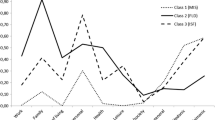Abstract
Anasakti, a Sanskrit term for traits like non-attachment, equipoise, selfless duty orientation, and effort in the absence of concern for the outcome, can be regarded as a Hindu-ideal cluster of personality traits. The relationship of Anasakti with well-being and the three distinct happiness orientations was explored through a study of 676 college students and a sample of 65 yogic practitioners in India. The findings revealed that the yogic practitioners were markedly higher in Anasakti than the secular population. For the yogic population, there was a large correlation between Anasakti and the Orientation to Meaningful Life, and it accounted for more than 20% of the variance in the regression of Anasakti against all the measures of well-being. The yogic population’s scores also correlated with several other measures of well-being. The scores of the secular population were less strongly related to the well-being scores; though, several correlation coefficients were statistically significant.

Similar content being viewed by others
References
Agarwal, A. (2004). Nishkama Karma Yoga and Anasakti; Motivation for self-realization. paper presented at national conference on Indian Psychology, Yoga and Consciousness: Pondicherry.
Bhushan, L. I., & Jha, M. K. (2005). Developing test of asakti and anasakti. Indian Journal of Psychometrics and Education, 36(1), 3–9.
Chinmayananda, S. (1975). The holy Gita. Bombay: Central Chinmaya Trust.
Csikszentmihalyi, M. (1990). Flow: The psychology of optimal experience. New York: Harper and Row.
Diener, E. (2000). Subjective well-being: The science of happiness and a proposal for a national index. American Psychologist, 55(1), 34–43.
Diener, E., Emmons, R. A., Larsen, R. J., & Griffins, S. (1985). The satisfaction with life scale. Journal of Personality Assessment, 49, 71–75.
Dockett, K. H., Dudley-Grant, G. R., & Bankart, C. P. (Eds.). (2003). Psychology and Buddhism: From individual to global community. New York: Plenum Publishers.
Fava, G. A., & Ruini, C. (2003). Development and enhancement of well-being enhancing psychotherapeutic strategy: Well-being therapy. Journal of Behaviour Therapy and Experimental Psychiatry, 34, 45–63.
Hoffman, K. T. (2007). A scale development and construct validation study of the Buddhist construct of non-attachment. Doctoral Dissertation submitted to Fielding Graduate University, Santa Barbara: California, USA.
Holmes, J. (1997). Attachment autonomy, intimacy: Some clinical implications of attachment theory. British Journal of Medical Psychology, 70, 231–248.
Jha, M. K. (2002). Certain psychological correlates of asakti-anasakti. Doctoral Dissertation submitted to T. M. Bhagalpur University: Bhagalpur.
Keyes, C. L. M. (2003). Complete mental health: An Agenda for 21st Century. In C. L. M. Keyes & J. Haidt (Eds.), Flourishing positive psychology and the life well-lived. Washington, DC: APA.
McIntosh, W. D. (1997). East meets west: Parallels between Zen Buddhism and social psychology. International Journal for Psychology of Religion, 7, 3.
Naidu, R. K., Thapa, K., & Das, M. M. (1986). On measuring indigenous concepts, unpublished manuscript. Allahabad: University of Allahabad.
Pande, N., & Naidu, R. K. (1992). Anasakti and health: A study of non-attachment. Psychology and Developing Societies, 4, 89–104.
Peterson, C., Park, N., & Seligman, M. E. P. (2005). Orientations to happiness and life satisfaction: The full life versus the empty life. Journal of Happiness Studies, 6, 25–41.
Ryan, R. M., & Deci, E. L. (2001). On happiness and human potentials: A review of research on hedonic and eudaimonic well-being. In S. Fiske (Ed.), Annual review of psychology (Vol. 52, pp. 141–166). Palo Alto, CA: Annual Reviews Inc.
Ryff, C. D., & Keyes, C. L. M. (1995). The structure of well-being revisited. Journal of Personality and Social Psychology, 69, 719–727.
Shaw, A. C. (1995). Perceptions of control, justice and hope: A study conducted in the Lillooet community. Thesis (M.A.), Simon Fraser University: USA.
Sinha, J. B. P., & Verma, J. (1992). Social support as a moderator of the relationship between Allocentricism and psychological well-being. Social and Applied Issues, (Vol. 10).
Sousa, L., & Lyubomirsky, S. (2001). Life satisfaction. In J. Worell (Ed.), Encylopedia of women and gender: Sex similarities and differences and the impact of society on gender (Vol. 2, pp. 667–676). San Diego, CA: Academic Press.
Tewari, A. K. (2001). Anasakti and mental health in the specific context of women. Paper presented at National Seminar on Psychology in India: Past, Present and Future. Kollam.
Tewari, A. K., & Srivastava, A. K. (1998). Mental health as related with anasakti, religiousity and aggression. Paper presented at the IX NAOP Congress, Vyas University: Jodhpur.
Tripathi, R. C., Naidu, R. K., & Biswas, S. N. (1993). Stress, health and performance: A study of police organization in Uttar Pradesh. Allahabad: University of Allahabad.
Vaillant, G. (2002) Aging Well. Boston: Little, Brown and Co.
Watson, D., Clark, L. A., & Tellegan, A. (1988). Development and validation of brief measures of positive and negative affect: The PANAS scales. Journal of Personality and Social Psychology, 54(6), 1063–1070.
Author information
Authors and Affiliations
Corresponding author
Rights and permissions
About this article
Cite this article
Banth, S., Talwar, C. Anasakti, the Hindu Ideal, and its Relationship to Well-Being and Orientations to Happiness. J Relig Health 51, 934–946 (2012). https://doi.org/10.1007/s10943-010-9402-3
Published:
Issue Date:
DOI: https://doi.org/10.1007/s10943-010-9402-3




